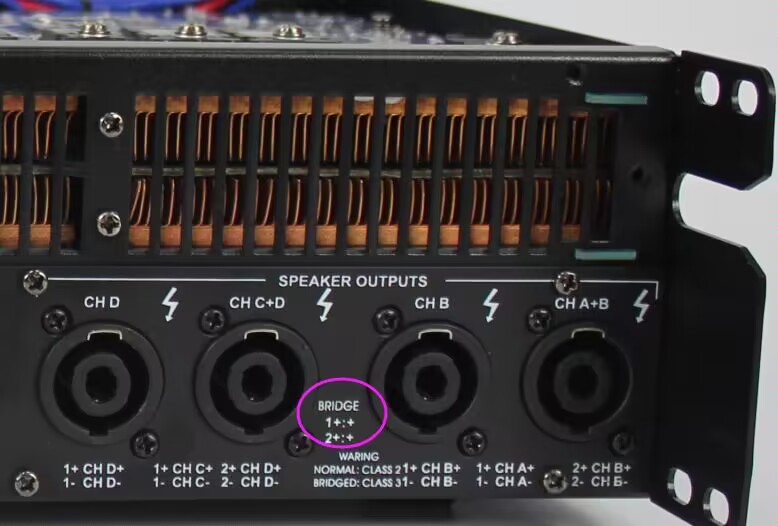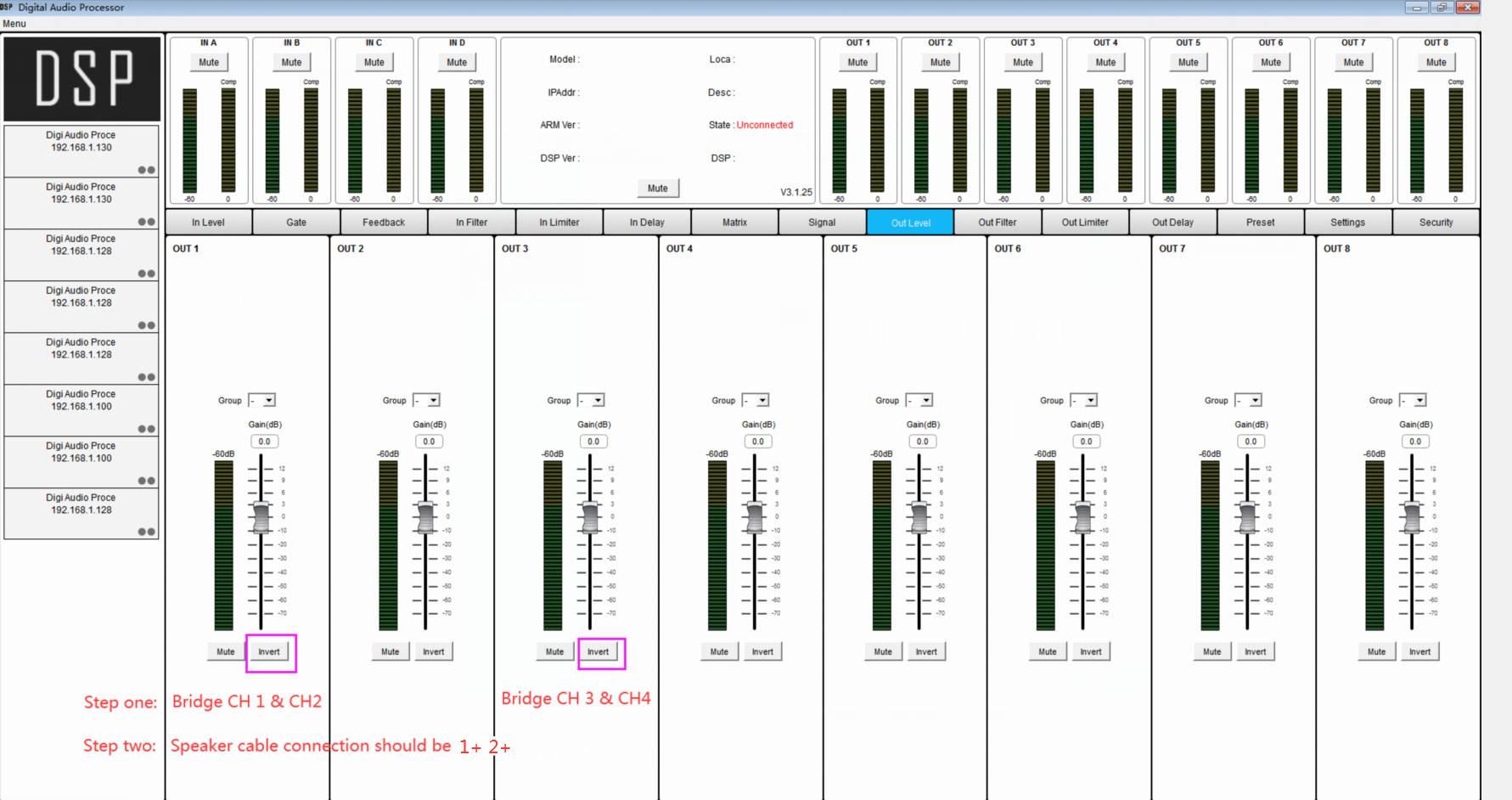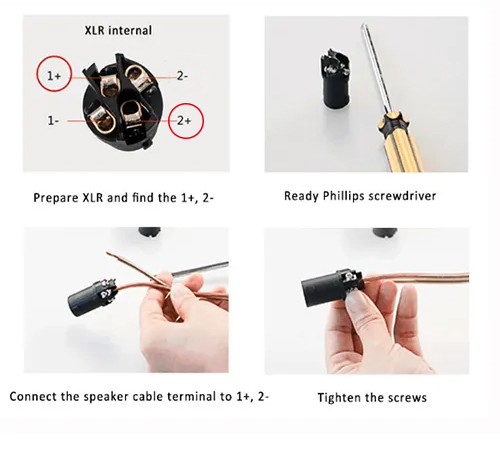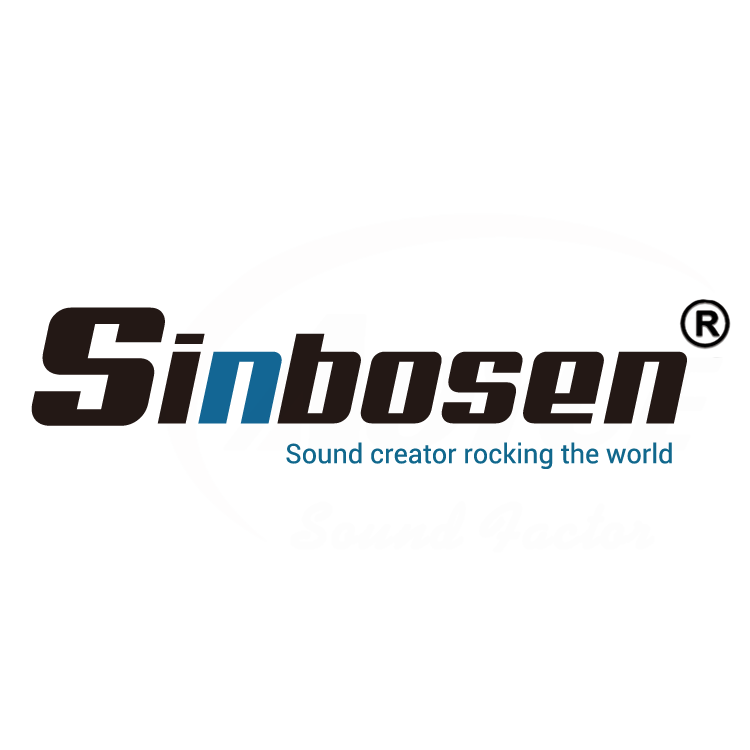Noticias de productos
The Bridge Mode of LA8 L-12X Amplifier!
: 12008
: 2024-01-08 19:37:45
Bridge mode is a connection method for power amplifiers in the professional audio field.
Most professional audio amplifiers support bridge connection. Set the amplifier status to bridge mode (BTL), and then connect the speaker wiring across the output stages (positive pole) of the two channels, and the speakers are not grounded. As for the positive and negative phases, the power amplifier will have BTL positive and negative poles.
The bridge connection of the audio amplifier is to push the output ends of the two amplification lines to a set of loads (speakers or speaker systems) at the same time.
When bridged, the audio waveforms output by the two amplification lines are in opposite phases and loaded on the speaker at the same time, so that the load has twice the audio voltage, thereby increasing the power four times (under the condition that the ideal current is sufficient and the load impedance is consistent ).
However, due to power limitations, the current cannot keep up, so the bridge connection is often not suitable for impedances lower than 8 ohms, so the output power is usually doubled.
Most professional performance, KTV and other power amplifiers support bridge mode. After adjusting the power amplifier to the bridge state, the speaker does not need to be grounded (the black negative terminal is open). The speaker wiring is connected across the two red output stages, and the phase The red binding posts will indicate the bridge phase (that is, the positive and negative poles).
So, under what circumstances do you need to use the bridging function and how to bridge it? How to calculate the power after bridging and what harm will using bridging do to the speakers?
01 Why bridge?
① In early power amplifier products, due to the limitation of component parameters, a single channel cannot achieve high power output. Using bridge mode can alleviate the desire for high power output;
② When the power of the single channel of the power amplifier is not enough to drive a large-power speaker (such as dual 18-inch subwoofers), the bridge mode needs to be used to meet the high-power demand of the speaker;
③ In order to save costs, power amplifiers with greater single-channel power are more expensive. Use bridge mode to meet high power output;
④ When there is a certain distance between on-site wiring, there are a large number of speakers with large power requirements, and the environment is relatively special, bridge mode will also be used to drive multiple high-power speakers.
02 How to bridge?
①Analog power amplifier
Generally, the input interface board is equipped with a toggle switch. Change the toggle switch on the back of the amplifier from studio (stereo) to bridge (bridged mono).
Wiring method: The positive pole of the speaker is connected to the positive pole of the left channel of the power amplifier, the negative pole of the speaker is connected to the positive pole of the right channel of the power amplifier, and the volume is controlled by the gain knob of the left channel!
② Digital power amplifier
Generally, there is a bridge button at the input end of the interface board; when using the bridge function, the bridge button needs to be in the ON state, but there is no bridge status indicator light;
When using the bridge function, connect any port of the two output SPEAKON sockets to 2+ and 2-.
Kind tips:
Because the output power of the digital power amplifier is very large, in order to reduce the port contact resistance (reduce the heat generation), it is best to use parallel connection.
OUT1 (1+, 2+) is connected to 1+ on the speaker end.
OUT2 (1-, 2-) is connected to 1- on the speaker side.
03 How to calculate power after bridging ?
Take a single channel with an 8 ohm load power of 200W as an example. At this time, each channel is U=Ua=Ub=40V. After bridging, Uab=Ua-Ub=40V-(-40V)=80V. When calculating the power, P=U*U /R=80*80/8=800W. For the same input signal, it can be seen that when the bridge is connected to the same impedance load, the power is four times that of the single channel.
However, in practical applications, due to the power provided by the internal power supply of the power amplifier machine, line loss, internal resistance of the power amplifier and other comprehensive factors, the ideal power output of 4 times is generally not achieved. A better quality digital power amplifier is 3.75 times, and an analog power amplifier is fully The power is only about 2.5.
①Amplifier bridging is often used for high-power subwoofers. Theoretically, it has an impact on sound quality, but the human ear cannot detect it. Use a bridged power amplifier to push the full range, and the sound coming out of the speaker will be very refreshing. As long as you control it well, it usually won't burn out.
It is common for speakers to burn out in discos. First of all, it is because the power configuration is not good, or the pressure limit is not adjusted properly, or the DJ's mixing console has reached the end of its level. If the input level of the mixing console is over the limit, but the output level is less than -10dB, it may burn out.
②Using a power amplifier bridge to drive high-power speakers is the last resort for system use, and it is a really impossible trick. Theoretically, the power is doubled and it can be propelled. But users have ignored a very important question. Theoretically, the power amplifier bridging refers to the case where the technical parameter indicators of the two channels are completely the same. In fact, it is completely impossible. Even the top foreign power amplifiers are very difficult to solve. It is difficult to make the left and right channels exactly the same.
Improper power mismatch during bridging leads to speaker burnout. First of all, it is caused by the crossover distortion caused by bridging and the parameter imbalance of the two channels.
Bridging is like having your legs and hands tied together. When you use it, you must maintain the harmony of your movements, otherwise you will make mistakes.
③Double "18" or double "15" or double "12" subwoofers are usually 4 ohms. As long as the function can be bridged under 4 ohms, it has nothing to do with the working mode. The reason why some power amplifiers have high power is that the internal circuits are bridged. Generally speaking, the power of ultra-low sound can be 3 times the extra power of the speaker. There are many factors that cause speaker burnout. In addition to the hardware itself, it is usually caused by improper operation by personnel.
How to set Bridge Mode?(Take LA8, LA12X as an example.)

Step One: Bridge CH1&CH2,Bridge CH3&CH4

Step Two: According to the picture, connect the speaker cable to XLR 1+, 2+.Speaker cable connection should be 1+ 2+.
RELATED PRODUCT:
Contact us:
 sales2@sinbosen.com
sales2@sinbosen.com
Whatsapp:https://api.whatsapp.com/send?l=en&phnoe=8616676738225
Website:https://www.sinbosenaudio.com/
Most professional audio amplifiers support bridge connection. Set the amplifier status to bridge mode (BTL), and then connect the speaker wiring across the output stages (positive pole) of the two channels, and the speakers are not grounded. As for the positive and negative phases, the power amplifier will have BTL positive and negative poles.
The bridge connection of the audio amplifier is to push the output ends of the two amplification lines to a set of loads (speakers or speaker systems) at the same time.
When bridged, the audio waveforms output by the two amplification lines are in opposite phases and loaded on the speaker at the same time, so that the load has twice the audio voltage, thereby increasing the power four times (under the condition that the ideal current is sufficient and the load impedance is consistent ).
However, due to power limitations, the current cannot keep up, so the bridge connection is often not suitable for impedances lower than 8 ohms, so the output power is usually doubled.
Most professional performance, KTV and other power amplifiers support bridge mode. After adjusting the power amplifier to the bridge state, the speaker does not need to be grounded (the black negative terminal is open). The speaker wiring is connected across the two red output stages, and the phase The red binding posts will indicate the bridge phase (that is, the positive and negative poles).
So, under what circumstances do you need to use the bridging function and how to bridge it? How to calculate the power after bridging and what harm will using bridging do to the speakers?
01 Why bridge?
① In early power amplifier products, due to the limitation of component parameters, a single channel cannot achieve high power output. Using bridge mode can alleviate the desire for high power output;
② When the power of the single channel of the power amplifier is not enough to drive a large-power speaker (such as dual 18-inch subwoofers), the bridge mode needs to be used to meet the high-power demand of the speaker;
③ In order to save costs, power amplifiers with greater single-channel power are more expensive. Use bridge mode to meet high power output;
④ When there is a certain distance between on-site wiring, there are a large number of speakers with large power requirements, and the environment is relatively special, bridge mode will also be used to drive multiple high-power speakers.
02 How to bridge?
①Analog power amplifier
Generally, the input interface board is equipped with a toggle switch. Change the toggle switch on the back of the amplifier from studio (stereo) to bridge (bridged mono).
Wiring method: The positive pole of the speaker is connected to the positive pole of the left channel of the power amplifier, the negative pole of the speaker is connected to the positive pole of the right channel of the power amplifier, and the volume is controlled by the gain knob of the left channel!
② Digital power amplifier
Generally, there is a bridge button at the input end of the interface board; when using the bridge function, the bridge button needs to be in the ON state, but there is no bridge status indicator light;
When using the bridge function, connect any port of the two output SPEAKON sockets to 2+ and 2-.
Kind tips:
Because the output power of the digital power amplifier is very large, in order to reduce the port contact resistance (reduce the heat generation), it is best to use parallel connection.
OUT1 (1+, 2+) is connected to 1+ on the speaker end.
OUT2 (1-, 2-) is connected to 1- on the speaker side.
03 How to calculate power after bridging ?
Take a single channel with an 8 ohm load power of 200W as an example. At this time, each channel is U=Ua=Ub=40V. After bridging, Uab=Ua-Ub=40V-(-40V)=80V. When calculating the power, P=U*U /R=80*80/8=800W. For the same input signal, it can be seen that when the bridge is connected to the same impedance load, the power is four times that of the single channel.
However, in practical applications, due to the power provided by the internal power supply of the power amplifier machine, line loss, internal resistance of the power amplifier and other comprehensive factors, the ideal power output of 4 times is generally not achieved. A better quality digital power amplifier is 3.75 times, and an analog power amplifier is fully The power is only about 2.5.
①Amplifier bridging is often used for high-power subwoofers. Theoretically, it has an impact on sound quality, but the human ear cannot detect it. Use a bridged power amplifier to push the full range, and the sound coming out of the speaker will be very refreshing. As long as you control it well, it usually won't burn out.
It is common for speakers to burn out in discos. First of all, it is because the power configuration is not good, or the pressure limit is not adjusted properly, or the DJ's mixing console has reached the end of its level. If the input level of the mixing console is over the limit, but the output level is less than -10dB, it may burn out.
②Using a power amplifier bridge to drive high-power speakers is the last resort for system use, and it is a really impossible trick. Theoretically, the power is doubled and it can be propelled. But users have ignored a very important question. Theoretically, the power amplifier bridging refers to the case where the technical parameter indicators of the two channels are completely the same. In fact, it is completely impossible. Even the top foreign power amplifiers are very difficult to solve. It is difficult to make the left and right channels exactly the same.
Improper power mismatch during bridging leads to speaker burnout. First of all, it is caused by the crossover distortion caused by bridging and the parameter imbalance of the two channels.
Bridging is like having your legs and hands tied together. When you use it, you must maintain the harmony of your movements, otherwise you will make mistakes.
③Double "18" or double "15" or double "12" subwoofers are usually 4 ohms. As long as the function can be bridged under 4 ohms, it has nothing to do with the working mode. The reason why some power amplifiers have high power is that the internal circuits are bridged. Generally speaking, the power of ultra-low sound can be 3 times the extra power of the speaker. There are many factors that cause speaker burnout. In addition to the hardware itself, it is usually caused by improper operation by personnel.
How to set Bridge Mode?(Take LA8, LA12X as an example.)

Step One: Bridge CH1&CH2,Bridge CH3&CH4

Step Two: According to the picture, connect the speaker cable to XLR 1+, 2+.Speaker cable connection should be 1+ 2+.

RELATED PRODUCT:
 |
 |
 |
 |
 |
Contact us:
Whatsapp:https://api.whatsapp.com/send?l=en&phnoe=8616676738225
Website:https://www.sinbosenaudio.com/








